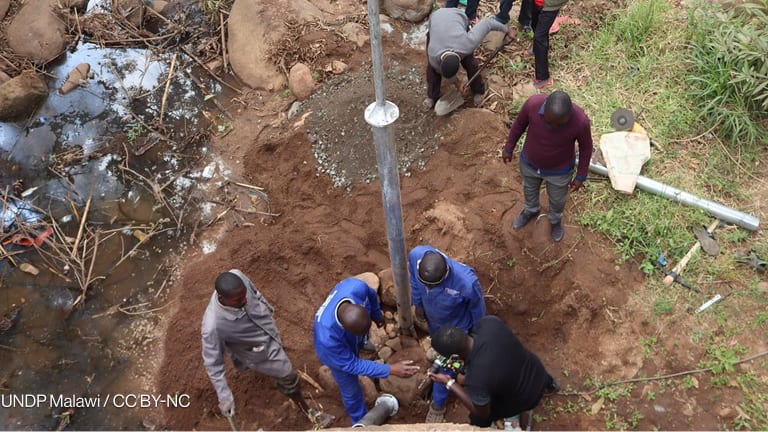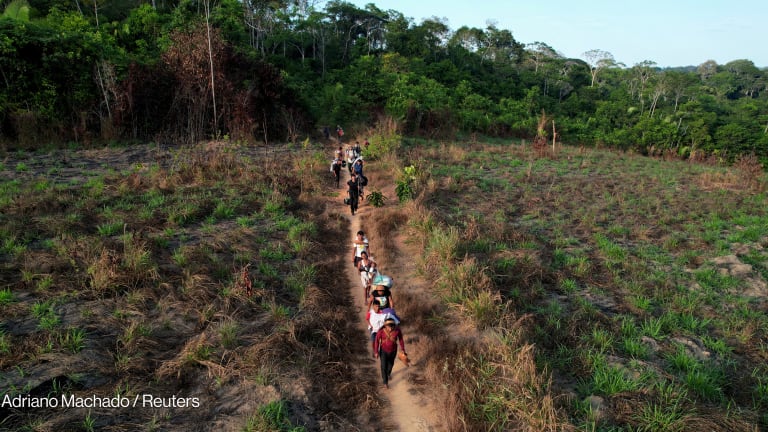The strategy behind ADB's massive climate finance numbers
Most of the Asian Development Bank's $4.3 billion adaptation finance is in the form of sovereign loans.
The Asian Development Bank’s recently announced climate finance numbers in 2023 amounted to a massive jump from the previous year: $9.8 billion committed, up from $6.7 billion in 2022. What’s more, the share counted toward climate adaptation — typically trickier to finance than projects designed to mitigate carbon dioxide emissions — leaped from $2.7 billion to $4.3 billion. We spoke with Warren Evans, ADB’s special senior adviser on climate change, to get more on the story behind those numbers, his take on the Just Energy Transition Partnerships with Indonesia and Vietnam, and what he sees as the major under-discussed challenge for climate finance in the years ahead. This conversation has been edited for length and clarity. So the first question is, how did ADB achieve this leap in its climate finance numbers? Well, it didn't happen overnight. There are three major shifts that ADB has made over about the last five years that resulted in this dramatic increase in climate finance this last year, and we expect it to continue along this trajectory. About five years ago, ADB started working with several countries on river basin flood risk management, recognizing the increased frequency and intensity of flooding that countries are going to face. And two of the very large loans approved last year — Philippines flood risk management and Indonesia flood risk management — were results of that. Then more recently, we really started shifting our focus. We've been working on climate proofing for a long time — doing a risk analysis of an infrastructure project, and what do you have to do to make sure that it is resilient to climate risks. That's just standard operating procedure now. Three or four years ago, we really shifted our focus from climate proofing to climate resilience. For some of the investments that we saw last year, some of the projects that were funded were community-based climate resilience. So asking “How do we do an irrigation project so that it not only generates the agricultural productivity benefits, but also really builds resilience of the farming communities and others to climate impacts?” The third thing that changed is that as a result of our new operating model, which came into effect last July, we're shifting the way we engage with countries. Everything that we do now is through a climate lens. So our country teams now, in addition to talking about economic development and human development and all the things that we've always talked about that generally lead to infrastructure investments for ADB, have really shifted to “What are your climate risks? What are your climate commitments for low-carbon development? What are the opportunities that we can support for low-carbon development and in particular, for building climate resilience?” “This is where I think many in the West get it wrong: They think of adaptation as something that you invest in for generating a revenue stream.” --— Warren Evans, special senior adviser on climate change, Asian Development Bank In Bangladesh, we had a results-based loan for urban resilience, for building climate resilience in municipalities. That will result in about 300 municipalities in Bangladesh going through a planning process to really understand what the risks are [and] what kind of investments are needed to build local resilience, community resilience, and urban resilience for the infrastructure. We also had a policy-based loan in Bangladesh, specifically on climate change, that was much more around the policy reforms required to ensure that they have the institutions they require, the regulations that are required, and the policy framework for resilience. But equally, what are the policy reforms to open up space for the private sector to come in more effectively and at scale on low carbon, on renewable energy? What are the financial mechanics of this? Where is the revenue stream? Where we can generate a revenue stream we try and do that. But the reality is, for much of what we're talking about, it's a public good. The justification for borrowing by the government is based on the economics around this, on the importance of really reducing the risks of climate impacts for their own economy. So it is based on the public good aspect of this. This is where I think many in the West get it wrong: They think of adaptation as something that you invest in for generating a revenue stream. The flip side of that is if you don't invest in building resilience, all you're gonna get is more of the same of what we saw in Pakistan, the droughts, the floods, all the disasters that we see. I think that the reality is that most of what we're going to do and most of the $4.3 billion is public sector investment, it's a sovereign loan, recognizing the importance for the economic well-being of the country. One concern with that model, however, is how to make sure countries are not having to take out a loan today to deal with storm surges, etc., and then becoming overly indebted as a result. And that's a legitimate concern. The need for concessional finance, the need for grant finance is real. It's justified, it’s real, and there's not nearly enough of it. That's the biggest problem we've got. We try to tap as much concessionality as we can in the countries that are the most vulnerable, and the poorest, that have the least capacity from the economy. But this isn't all that different, if you think about it, from countries’ public sector investments, in roads, in public health systems, and education. Because when we do this, by focusing on sectoral investments — water resources, irrigation, agriculture, health — by focusing on those sectors, but then flipping the design of the project to build resilience, while we still achieve the objectives of the sectoral investment, there is a return for the economy. But it's more sustainable because we're dealing with the risk of climate change. One problem with climate finance at the moment is that no one seems to agree on how to define it. Reuters had a story last year showing donors counting all sorts of things, like hotels and airports, as part of their climate finance. What do you make of this debate? And what do you do internally to make sure that your climate finance is bona fide climate finance? We scrutinize everything that we count as climate finance really, really closely. So we welcome any review of how we're counting our climate finance. The multilateral development banks have agreed on a methodology for this. For us, it's pretty clear. For adaptation, it’s either climate proofing or building resilience to climate risks. And there are a huge range of investments that involve that and there's a need to be very careful to be consistent in how you count it. On the mitigation side, it's a little bit easier because you're either reducing emissions or you're not. And it's much easier to quantify, from a dollar point of view, the amount of funding that's going in for emission reductions, as opposed to adaptation. How do you assess progress on the Just Energy Transition Partnerships? I think the JETP for Indonesia, where we're supporting the secretariat and managing the technical stream, is working pretty well. There's some frustration from some of the donors in the pace. But our view is that it's actually going OK because the important thing is that the Indonesians own it, and they have taken ownership of it. Vietnam is delayed because the government just hasn't as actively bought into this as in Indonesia. What will be the main developments in climate finance in the next few years? I think in a year, you're going to hear a lot of noise about what's going on in the high mountains, the Hindu Kush Himalaya, the glacial melt, but also in Tajikistan and Kyrgyz Republic. Huge, huge problems and it's only now really showing its evil future. As an example, ADB financed a major water supply program for Kathmandu Valley over the last 10 years. We were getting ready to commission it two years ago, and a glacial lake outburst flood came down and wiped out the intake structure for this water supply. And so we're now scrambling to figure out where we're going to put a new intake structure because we simply can't put it up where it was. And of course, when the project was designed 15 years ago, nobody was thinking about this. So the whole issue of glacial lake outburst, glacial melt — that had a lot to do with the floods in Pakistan, two years ago. That I think is going to be a huge issue that is extremely challenging.
The Asian Development Bank’s recently announced climate finance numbers in 2023 amounted to a massive jump from the previous year: $9.8 billion committed, up from $6.7 billion in 2022.
What’s more, the share counted toward climate adaptation — typically trickier to finance than projects designed to mitigate carbon dioxide emissions — leaped from $2.7 billion to $4.3 billion.
We spoke with Warren Evans, ADB’s special senior adviser on climate change, to get more on the story behind those numbers, his take on the Just Energy Transition Partnerships with Indonesia and Vietnam, and what he sees as the major under-discussed challenge for climate finance in the years ahead.
This story is forDevex Promembers
Unlock this story now with a 15-day free trial of Devex Pro.
With a Devex Pro subscription you'll get access to deeper analysis and exclusive insights from our reporters and analysts.
Start my free trialRequest a group subscription Printing articles to share with others is a breach of our terms and conditions and copyright policy. Please use the sharing options on the left side of the article. Devex Pro members may share up to 10 articles per month using the Pro share tool ( ).
Vince Chadwick is a contributing reporter at Devex. A law graduate from Melbourne, Australia, he was social affairs reporter for The Age newspaper, before covering breaking news, the arts, and public policy across Europe, including as a reporter and editor at POLITICO Europe. He was long-listed for International Journalist of the Year at the 2023 One World Media Awards.








